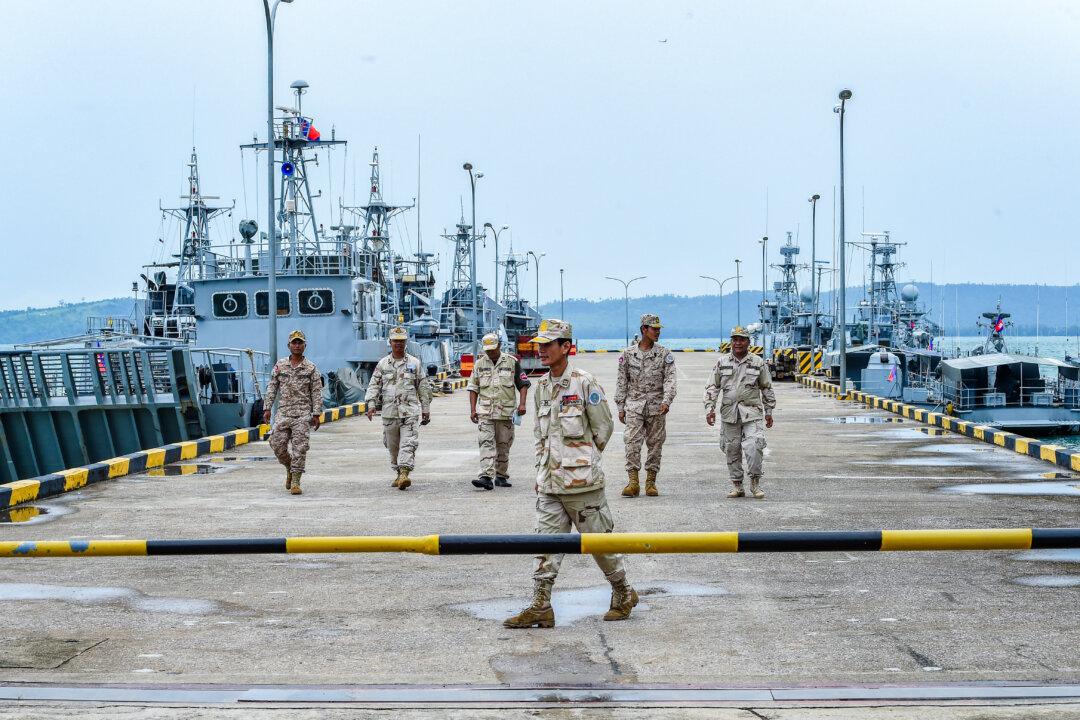Commentary
The Chinese Communist Party (CCP) has officially completed the inauguration of its upgraded naval base at Ream, Cambodia—an expansion that mirrors China’s overseas
base in Djibouti and heightens fears of growing CCP military encroachment in the South China Sea.
Earlier this month, Cambodia and China inaugurated a joint logistics and training center at the Ream Naval Base, marking Beijing’s second publicly acknowledged overseas military facility after Djibouti. The Chinese-funded upgrades include a dry dock and a 650-meter pier capable of hosting warships of up to 20,000 tonnes, excluding only China’s largest aircraft carriers.
Strategically located on the Gulf of Thailand with direct access to the South China Sea, Ream is Cambodia’s only naval base with such reach. The project follows Cambodia’s 2020 demolition of a U.S.-built facility at the site and its rejection of Washington’s offer to repair it.
China portrays the expansion as part of its broader strategy to diversify maritime access and de-risk supply chains, allowing it to bypass regional chokepoints controlled by Vietnam, Singapore, and Indonesia. While Beijing and Phnom Penh claim the base is intended solely for joint training, counter-terrorism, and humanitarian missions—not military expansion—the United States remains unconvinced.
American officials warn that China’s involvement threatens Cambodian sovereignty and could significantly
expand Beijing’s military footprint in the region. These concerns are echoed by several
Southeast Asian nations that are already alarmed by the CCP’s sweeping territorial claims in the South China Sea. The Ream base’s strategic location and enhanced capabilities only add to concerns that it may serve as a platform for projecting Chinese naval power across contested waters.
The day after the inauguration, China and Cambodia launched the Golden Dragon 2025 joint naval exercises at the newly expanded Ream Naval Base. The drills, which included warship formation maneuvers and logistical training, utilized the newly completed facilities, demonstrating that the base is now fully operational and capable of supporting advanced military operations. Although Golden Dragon is not a new exercise, this iteration marks a turning point, serving as a public showcase of the base’s upgraded capabilities and the growing military alignment between China and Cambodia.
Chinese warships have maintained a persistent presence at Ream since at least 2023, and Beijing reportedly plans to transfer vessels to Cambodia while training local crews. The timing and scale of this year’s drills have heightened concerns over the base’s potential use by the People’s Liberation Army Navy. While previous exercises attracted little attention, this iteration marks Ream’s emergence as a platform for power projection, testing both the base’s operational readiness and the international response, particularly from the United States and ASEAN members.
Cambodian Prime Minister Hun Manet insists the upgraded Ream Naval Base remains under
national control and is open to all friendly nations, including the United States and Japan. Citing the country’s constitutional ban on exclusive foreign military bases, he has repeatedly denied accusations that the facility could become a permanent outpost for the Chinese military. Nonetheless, the base’s expanded capabilities have deepened U.S. and regional concerns, particularly as the Pentagon warns that Beijing is building a global logistics network to disrupt American operations.
Unlike China’s fully Chinese-operated base in Djibouti, Ream is presented as a joint venture, and Cambodia appears to be carefully managing perceptions. In a calculated act of diplomatic balancing, Cambodia invited the U.S. Navy to dock at Ream in December 2024. Most recently, two Japanese warships docked at the Ream on April 19—the first foreign vessel to visit the upgraded facility. Japan, seen as a U.S. ally yet less provocative than the United Kingdom or Australia in the China–U.S. rivalry, offers Phnom Penh a way to signal neutrality without antagonizing Beijing.
Still, the timing of the Golden Dragon 2025 underscores Cambodia’s growing military alignment with Beijing. The government’s invitations to other navies, while aimed at projecting openness, have done little to calm fears in Washington or among ASEAN members, such as Vietnam and the Philippines. Many remain wary that Ream, despite official assurances, could function as a de facto Chinese permanent base.
The base, combined with other major Chinese infrastructure projects in Cambodia, underscores the CCP’s growing influence in the region and comes amid increasingly strained U.S.–Cambodia military relations. One key project closely tied to the base is the $1.7 billion China-funded Funan Techo Canal, which would connect Phnom Penh to the Gulf of Thailand, offering an inland route that bypasses Vietnamese-controlled ports. Analysts suggest the upgraded Ream facility may serve as a
security guarantee for the canal, reinforcing China’s efforts to secure alternative maritime access and expand logistical reach.
Amid Burma’s
ongoing civil war and the aftermath of a devastating earthquake, the Chinese regime’s influence in the country continues to deepen. Laos has long functioned as an
economic client state of Beijing, and now, with a naval base in Cambodia, the CCP has effectively co-opted three of ASEAN’s 10 member states. As the CCP tightens its grip on mainland Southeast Asia, it edges ever closer, threatening U.S. allies like the Philippines.
Views expressed in this article are opinions of the author and do not necessarily reflect the views of The Epoch Times.







